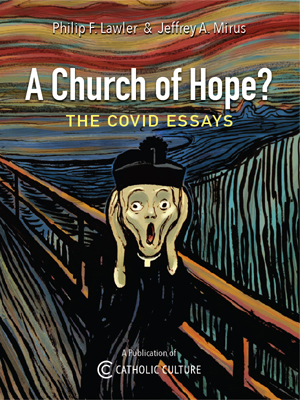To Kneel Or Not To Kneel. . .
At the end of July, the Vatican's Congregation for Divine Worship and the Sacraments, headed by Cardinal Jorge Medina Estevez, issued the first revision in 25 years of the General Instruction of the Roman Missal, an introduction to and commentary on the entire Missal. The July 28 Latin-language instruction introduces numerous minor changes in the way Mass is to be celebrated.
The instruction clarifies that communicants are never to receive the sacrament from one another, but only from the priest or another eucharistic minister.
It also takes a clearer stand on a controversy of recent years by declaring that it is "desirable whenever possible" for the priest to celebrate Mass facing the people. Some Catholic groups -- including the Pope's chief doctrinal advisor, Cardinal Joseph Ratzinger -- have argued in recent years that the Church should adopt the view that the preferable form of celebration is for priest and people alike to face eastward, which would entail the priest having his back to the people, as in the Tridentine rite. The 1975 instruction simply said the altar in every church "should be free-standing to allow the ministers to walk around it easily and Mass to be celebrated facing the people." The new instruction repeats those words, but after "facing the people" it adds, "which is desirable whenever possible."
The location of the tabernacle has been another source of ongoing controversy. The 1975 instruction expressed strong preference for "eucharistic reservation in a chapel suited to the faithful's private adoration and prayer. " It said the tabernacle could be placed in the sanctuary if a chapel of reservation "is impossible because of the structure of the church."
The new instruction gives equal weight to the options of reserving the Eucharist in a chapel or "in the sanctuary, apart from the altar of celebration." If a chapel of reservation is used, it says the chapel should be "integrally connected with the church" and "conspicuous to the faithful." If the tabernacle is in the sanctuary, it should "not be on the altar on which Mass is celebrated," the instruction says -- answering a question of some who argued the 1975 instruction did not prohibit placing the tabernacle on the altar of celebration.
The new instruction says the decision on placement of the tabernacle belongs "to the judgment of the diocesan bishop."
It adds that if the reserved Eucharist is in the sanctuary, "the priest, deacon and other ministers genuflect to it when they approach or leave the altar, but not during the celebration of Mass itself -- clarifying a vagueness in the previous instruction which led some to argue that the priest and other ministers should genuflect to the tabernacle whenever they crossed in front of it during Mass.
The instruction says that, when other ministers would genuflect, those carrying the processional cross or candles bow instead. Only those who are not engaged in ministry during the Mass genuflect whenever they "cross before the most Blessed Sacrament," and they do not do so if they are in a procession.
The US bishops' Committee on the Liturgy has prepared an English study translation of the text. By agreement with the Holy See, the committee has posted the official Latin text of the instruction on the Internet for viewing or downloading at www.nccbuscc.org/liturgy/current/missalisromanilat.htm.
The instruction is meant to accompany the third edition of the Roman Missal and will take effect with the promulgation of that missal, which is to be published later this year.
Most of the new instruction simply repeats the norms and regulations of the 1975 instruction. In fact, the entire "Introduction," setting out the historical, theological and spiritual framework for the document, is virtually identical to the one published in 1975.
In many places where the new instruction is different, the difference is simply additional language to clarify or spell out more specifically what a rule or statement means. But in some places new rules are set out, especially where there have been disputes over contrasting interpretations of the 1975 document. Many such additions reflect Vatican rulings over the past 25 years in response to questions about the 1975 text.
Some practices previously allowed or not addressed in the 1975 instruction are prohibited by the new instruction:
1) There is a specific prohibition against carrying the Lectionary in the entrance procession. Like the 1975 instruction, the new one says that the deacon or a reader may carry the Book of the Gospels in the opening procession. But the new one adds the words, "The Lectionary is never carried in procession."
2) The new instruction says that only a priest, deacon or instituted acolyte is to clean the sacred vessels after Communion or after Mass. Other eucharistic ministers or Mass servers are not permitted to do so. Under the 1975 instruction it had become common practice in many US parishes for lay ministers of the Eucharist to cleanse the vessels.
3) Lay eucharistic ministers are also barred from assisting the priest in breaking the bread. The new instruction says, "This rite is reserved to the priest and the deacon."
4) Lay eucharistic ministers "do not approach the altar before the priest has received Communion and always accept from the hands of the priest the vessel" from which they distribute Communion.
5) The new text says that to avoid disrupting the celebration the priest should not leave the sanctuary white exchanging the sign of peace. The old text said only mat the priest "may give the sign of peace to the ministers. " The new text adds that he should remain in the sanctuary for that and "do likewise if for a good reason he wishes to offer the sign of peace to a few of the faithful."
6) The new instruction specifically bans the substitution of other hymns for chants found in the Order of the Mass, such as the Gloria or Agnus Dei.
The old and new texts alike cite "noble simplicity, not ostentation," as a basic norm for church furnishings. But the new text is slightly less restrictive in its treatment of the use of sacred images in church.
The old version said of images, "There is need both to limit their number and to situate them in such a way that they do not distract the people's attention from the celebration. There is to be only one image of any one saint."
The new version says that, "care should be taken that their number is not increased indiscriminately, and that they are situated in such a way that they do not distract the faithful's attention from the celebration. There is to be only one image of any given saint as a rule."
The sacrarium, a basin that empties directly into the ground, was not mentioned in the 1975 instruction but the new text says, "The custom of building a sacrarium in the sacristy into which water from the cleansing of the sacred vessels and linens is poured should be observed."
The new instruction specifies that the processional cross is to be "adorned with the figure of Christ crucified." If there is another cross on or near the altar, it, too, is to have "the figure of Christ crucified upon it."
In general, the new text gives increased emphasis to the proper blessing and care of those things intended for use in the liturgy. The new text reiterates the 1975 rule that all those attending Mass should observe "uniformity in standing, kneeling or sitting" as a sign of their unity. But the new text strengthens this rule by preceding it with the statement that "greater attention needs to be paid to what is laid down by liturgical law and the traditional practice of the Roman Rite, for the sake of the common spiritual good of the people of God rather than to personal inclination or arbitrary choice."
The new instruction spells out what a genuflection is and what it means: "A genuflection, which is made by bending the right knee to the ground, signifies adoration." This differs from a bow, which is a sign of reverence, or the kiss of the altar or the Gospels by a priest or deacon, which signifies veneration.
The instruction goes on to specify that, because it is a sign of adoration, the genuflection "is reserved to the most Blessed Sacrament and to the Holy Cross, from the solemn adoration in the liturgy of Good Friday until the beginning of the Easter Vigil." People "should kneel at the consecration, except when prevented by reasons of health, lack of space, the number of people present or some other good reason," the new text says. That phrasing adds "reasons of health" to the 1975 list of possible exceptions to the rule.
The old instruction said nothing else about the posture of those who are not kneeling at the consecration, but the new one says that they "ought to make a profound bow when the priest genuflects after the consecration." A profound bow is a bow of the body from the waist.
This item 3432 digitally provided courtesy of CatholicCulture.org






